Paella Recipe

As some people who follow my blog may already know, I have recently moved to France and have begun to immerse myself in the country's culture. Along with traveling the country and surrounding area, I have also begun to experiment with learning some local French recipes, which I have actually extended to incorporate basically any European recipe that I find interesting and which has some sort of traditional background. For instance, I started with the French dish Bœuf Bourguignon and have made it on several occasions since being here.
For my next recipe though, I decided to make the traditional Spanish rice and meat dish known as Paella. I first saw the dish on a cooking show and for some unknown reason was immediately drawn to it. I have made it twice so far and already know that it will remain a staple for me for many years to come.
Brief History
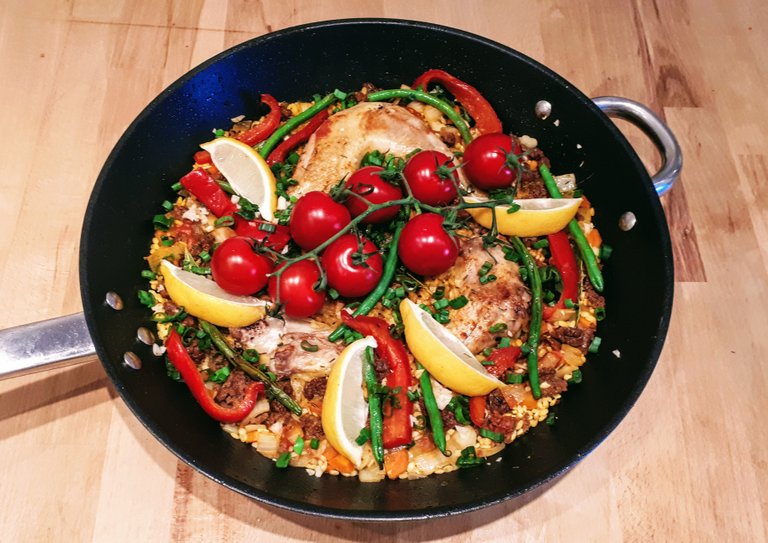
Feel free to skip this part if you're like me and hate it when people ramble on about the history of a dish or how they learned to cook from their grandma or long lost auntie, when all you really care about are the ingredients and directions for the recipe.
Though there are many different versions of Paella recipes today, each with a variety of different meat and seafood combinations, it seems that traditional Paella was made with rice and saffron and chicken, rabbit and snails as the main sources of protein.
We don't really eat snails back in Canada but after moving to France I totally understand why Europeans eat them as a source of protein. Unlike the grape sized snails that we see in Canada, the snails here in France are the size of golf balls or in some cases even larger.
Though I can find many large snails in my back yard, ones that would easily be large enough to eat, I just couldn't bring myself to cook them so I left them out of this particular recipe.
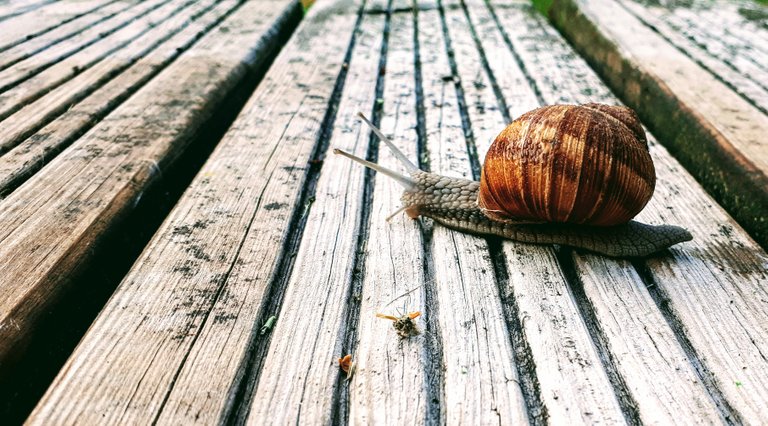
Though there seems to be a few different stories of where the term Paella comes from many online sources agree that it actually refers to the pan in which the dish is cooked. Paella was traditionally cooked on an open fire using small twigs and branches found in the country. A lack of an abundance of large lumber in the nation made it challenging to build large fires that could boil water in the traditional large rounded pots. As such, Paella uses a much shallower pot with a flat bottom which maximizes the surface area of the pot that remains in contact with the rice in the pan and the small fire that it is cooked over. The pots design makes boiling water much easier then with a round bottom pot and is ideal for cooking this dish made with rice.
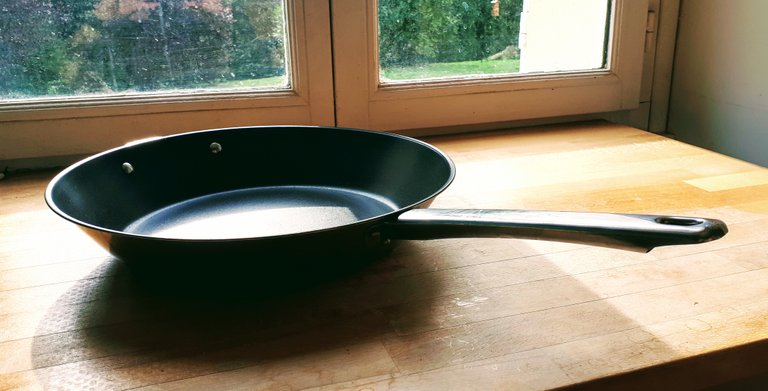
This is not a traditional Paella pan. This is the €19 Ikea non-stick frying pan that I used to cook my Paella. If you're not a purist chef something like this will work as long as all of the rice is covered in liquid when cooking.
Ingredients
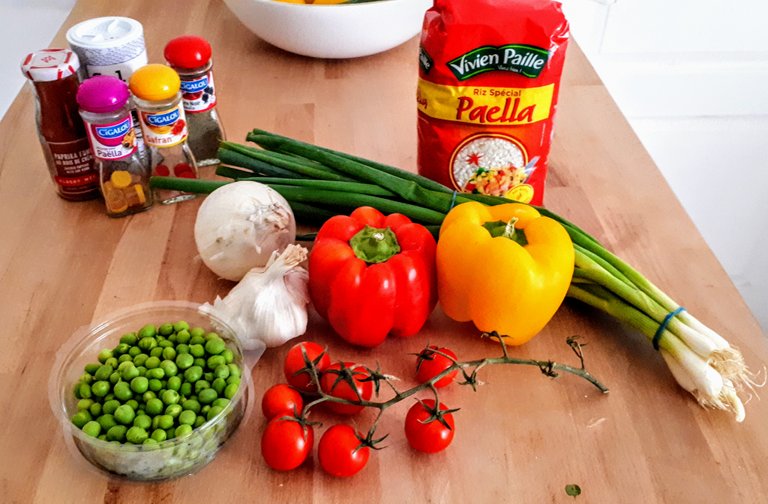
Though I tried cooking rabbit in my second attempt at this recipe I personally didn't much care for it, so this will be a chicken and chorizo sausage version of the dish. I didn't use chorizo sausage in my first attempt but having used in my second attempt I now feel that it is a must as it really added a lot of flavor to the dish.
3-4 Chicken legs and thighs
Chorizo sausage
Paella or arborio (short grain risotto style rice)
Onions
Bell peppers
Cherry tomatoes preferrably on the vine
Peas (or green beans if you prefer)
Lemon wedges
Chicken stock
Garlic
Saffron (a must)
Paella spice (I found this at the grocery store but I have no idea what's in it so dont ask)
Smoked paprika
Salt and pepper to taste
Green onions or parsley for garnish
Directions
As far as I can tell, there is only one rule when cooking Paella and that is
YOU DO NOT STIR THE RICE!"
The reason for this is because a successful paella will have a "socarrat" which is a crispy, almost slightly burnt layer of rice at the bottom of the pan. This layer adds texture and crunch to the dish as well as an excellent smokey caramelized flavor. It also makes it seem more traditional as one can imagine that the dish was cooked over an open flame as it was meant to be in the past.
I started by browning the chicken on both sides and basically cooking it all the way through. Once that was done I set it aside for later.
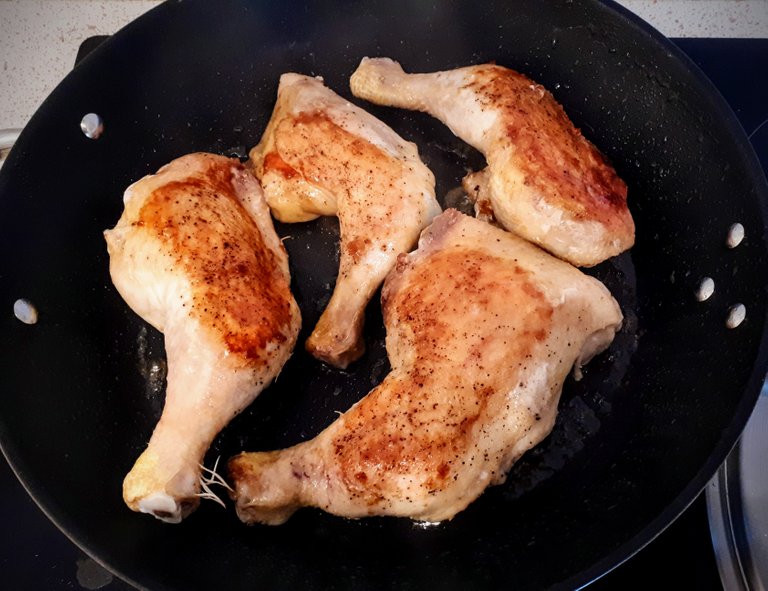
While the chicken was cooking I prepared the vegetables by giving them a chop. I wanted there to be consistency in the dish so I cut everything into an equal size. I basicall just matched the size of the peas.
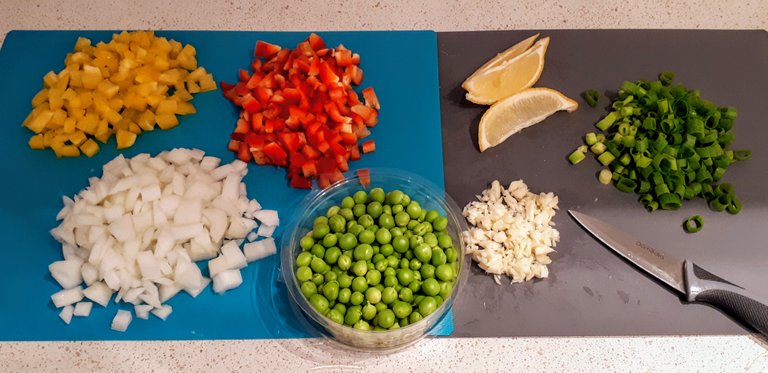
Once the chicken was finished I cooked the sausage and also set that aside for later. The sausage was quite fatty but instead of draing away the fat I used it to add more flavor and richness to the dish. I sauted the onions and spices (saffron, paella spice, paprika, salt and pepper) in the fat to bring out some more flavor.
You could drain the fat from the dish if you prefer it to be a bit more lean.

From here I added the rice to the onions and spices and tried to toast them as best I could.
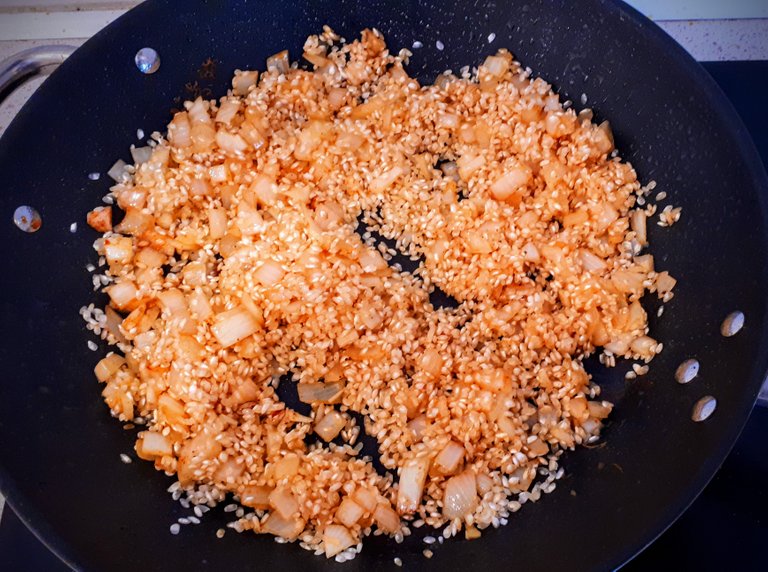
Next I added the cooked sausage to the rice and added chicken stock until the rice was entirely covered. I would also recommend adding the chicken back to the pan at this point so that it too absorbs some of the flavors from the spices and broth. To do this you have to place the chicken where you want it in the rice as you cannot stir the pot for the remainder of the cooking process. I cooked the rice partially uncovered and partially covered.
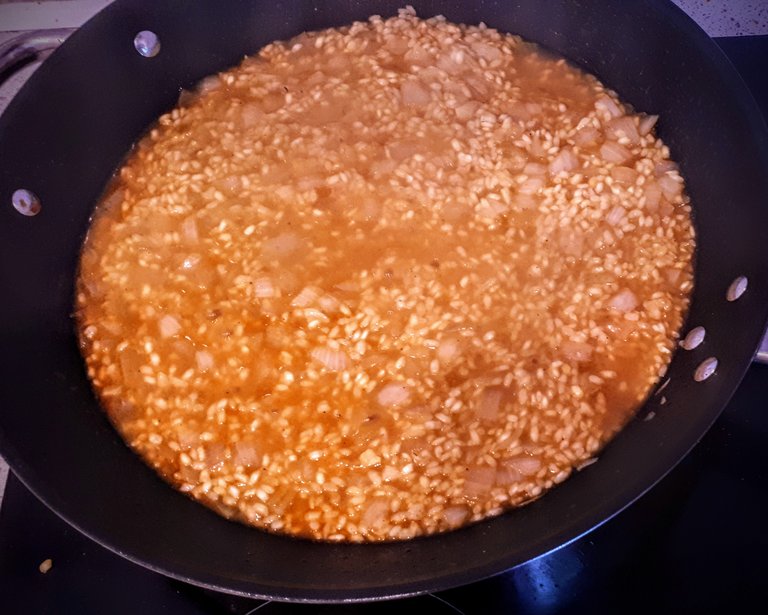
From here you can pause and have a glass of wine while you wait for the rice to absorb the liquid and cook.

"Okay perfect, while you're having your wine I'm just going to check the rice and see if it needs a quick stir!"
"Don't you F***ing touch that rice!"

Once the rice is nearly cooked you can add in the peas and peppers. I personally like these vegetables to be slightly under cooked to ensure that their color stays vibrant when the dish is served. This is slightly tricky in this dish because you cannot disturb the rice so they basically have to be added gently in a way that will allow them to be steam cooked by the remaining liquid in the pan. I also added the tomatoes and the lemon wedges at this point.
From there I turned up the heat a bit for a brief period of time (maybe 1 minute or so) then I reduced the temperature way down and put the lid on the pan to steam the rice and newly added veggies.
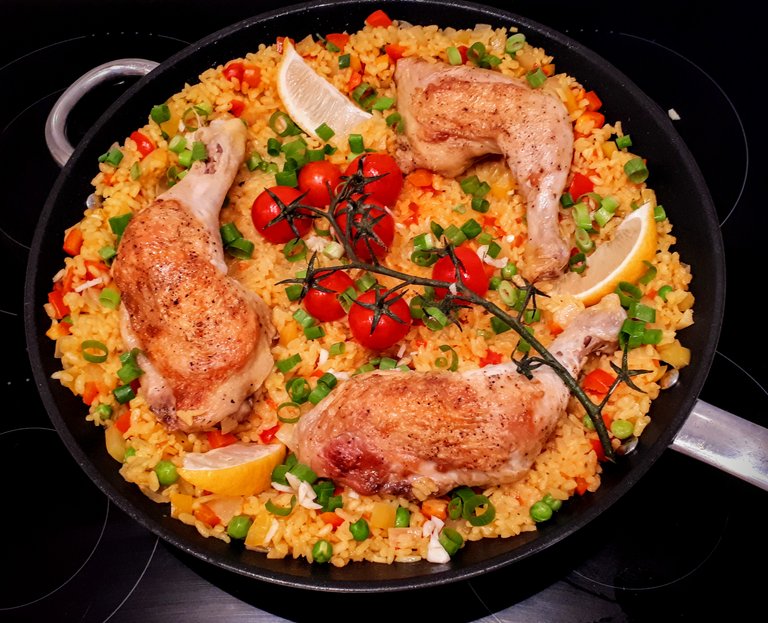
When everything was cooked the way I wanted it to be I removed the pan from the stove. Whether or not the dish has a socarrat at this point is a bit of a mystery and guess. Its probably more of an art then a science so you just have to take a chance I suppose. As you can see in the image below, I was able to create a socarrat which in my opinion was actually the best part of the dish.
My understanding is that Paella is traditionally served family style in the pan it was cooked in as well so that is what I would recommend also.

Downvote: tag abuse #spanish
Posted using Partiko Android
Why is it abuse? The recipe is a traditional dish from Spain. I've never used the tag so maybe I dont fully understand it. Is the tag only meant for posts written in the spanish language?
Posted using Partiko Android
Yep, the dish as #Spain food... #spanish is a tag for spanish language post.
Okay that's fair. Thanks for the info. I removed the tag.
Posted using Partiko Android
Thank you for your understanding, downvote up..!
P.S. and upvote the recipe...i'm hungry...!
Thanks. I appreciate it. I appreciate the feedback along with the downvote as well. I feel like I learned something that I didnt realize before and the issue got resolved in the end. That probably wouldnt have happened with a downvote but no explanation, so thanks for that. I think we just proved that communication works lol
Posted using Partiko Android
Of course it is! But, to tell the truth, it took me a long time to reach this level of understanding, mainly because I saw downvotes as a weapon of punishment and not as what it really is: a way of orientation if you know how to use it effectively. In this way, we will make a blockchain with less garbage and better content.
Greeting from Venezuela...
Shall I down vote your comment then? The #Spain tag is not listed under Steemit's list of recognized tags.
See for yourself: https://steemit.com/tags
Maybe you should flag (changing the name of the down vote doesn't change it's nature) Steemit for not providing relevant tags.
Saludos!
If the #spain tag does not appear in the list you provide, it does not mean that it does not exist. That link you mention will only list the most used tags by the community (the most popular ones). That said, the correct label to refer to a dish native to any country is the country itself (in this case #spain); #spanish only serves as a label in those publications where the referenced language is used partially or totally.
Thank you for contributing to the debate.
Manually curated by the Qurator Team. Keep up the good work!
You are a thoroughly nice and decent Steemian. The downvote was proposterous. Of course it was not "abuse of a tag" to tag this post Spanish. Nothing more Spanish than a paella after all. Let us focus on the excellent quality of your post rather! It is not that you only have to say nice, non-commital things about other people's posts, I don't think, but how interested anyway is the downvoter I am referring to in anything Spanish I wonder if they can only think negatively ( a minus-vote, after all).
Besides, how are we supposed to know what all tags are "supposed to be used for"?? I am becoming scared to post at all - and shall be inventing my own tags in Kiribatian from now on to avoid offending anyone.
Downvotes are horrible to receive and not at all educational in my book. But I admire you taking it all in your stride with great politeness to boot. Chapeau!
I appreciate your support but I do think that the situation worked itself out in the end because we were able to discuss the matter. I agree with you that they tags can be a but challenging at times. Thanks again for the nice words and the support :)
Posted using Partiko Android
Hello, @leaky20! We heartily appreciate the time and effort you put towards your DIY/How-to article. It is, for this reason, we built a frontend/condenser known as Build-it, where your efforts are fairly rewarded. At Build-it we welcome all sorts of DIY, How-to, and Lifehack articles.
Build-it is a tribe on the steem that sharpens your #diy and #how-to skills, in an attempt to save more money for yourself.
The recommended tags required when creating a DIY article are #diy, #build-it. #how-to, or #doityourself. You'll get rewarded with BUILD tokens from our @build-it.curator account upon every valid post/project which can also be exchanged for steem on steem-engine when you use any of the recommended tags as well as posting via our website.
Need help? Live technical support on Discord or Telegram
This project is run and supported by our witness @gulfwaves.net. If you think we're adding value to the steem platform, your witness vote will be appreciated! Click here to vote for us
Koreans eat lots of snails, especially big sea snails and also mini ones too. Your snail 🐌 picture is cool and so clean and crisp. Neat pic. Your recipe for this dish looks tasty. Do the lemons make a big difference?
Posted using Partiko Android
I have had snails and enjoyed them but they are quite rare in Canada.
I actually think that the lemons make quite a bit of difference. They add a lot of flavor. They could be removed for sure if you dont like lemon of if they are hard to come by but again, I do think that they add quite a bit to the dish
Posted using Partiko Android
Tasty stuff! I can't cook rice very well, so mainly use my rice cooker. If I cooked this I imagine the rice would be under cooked or mushy, rather than a tasty dish with crisp socarrat like yours. Good job @leaky20!